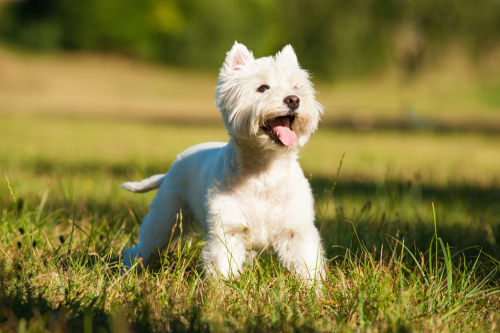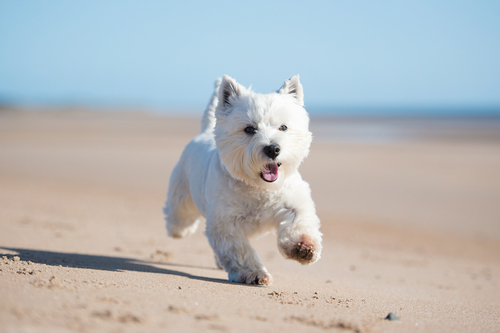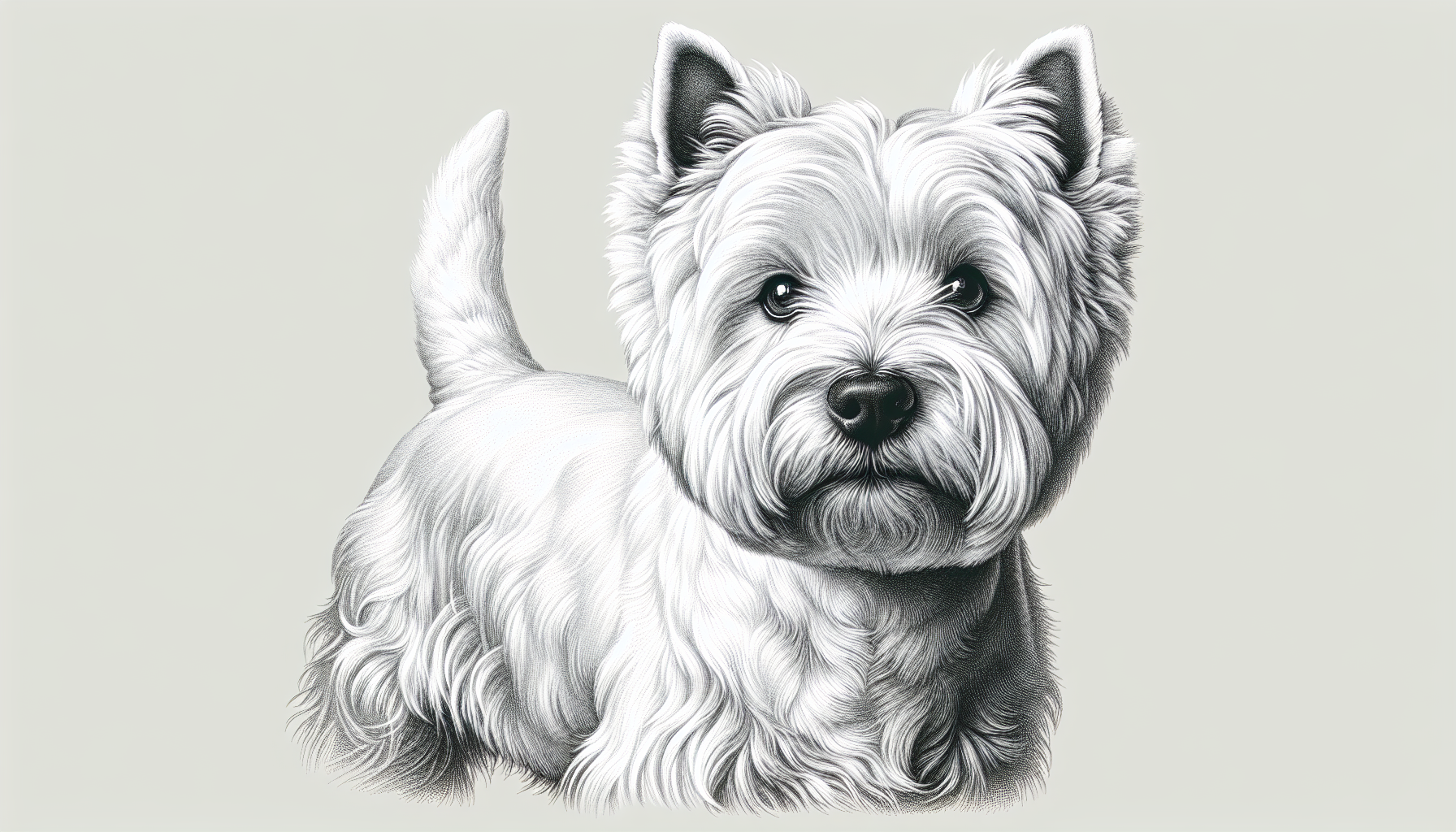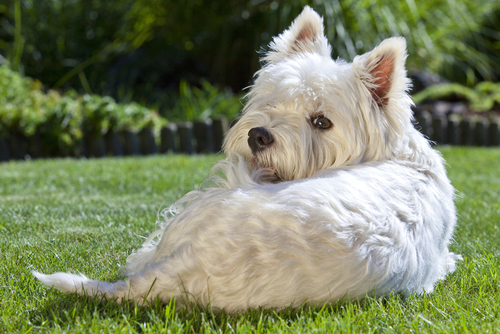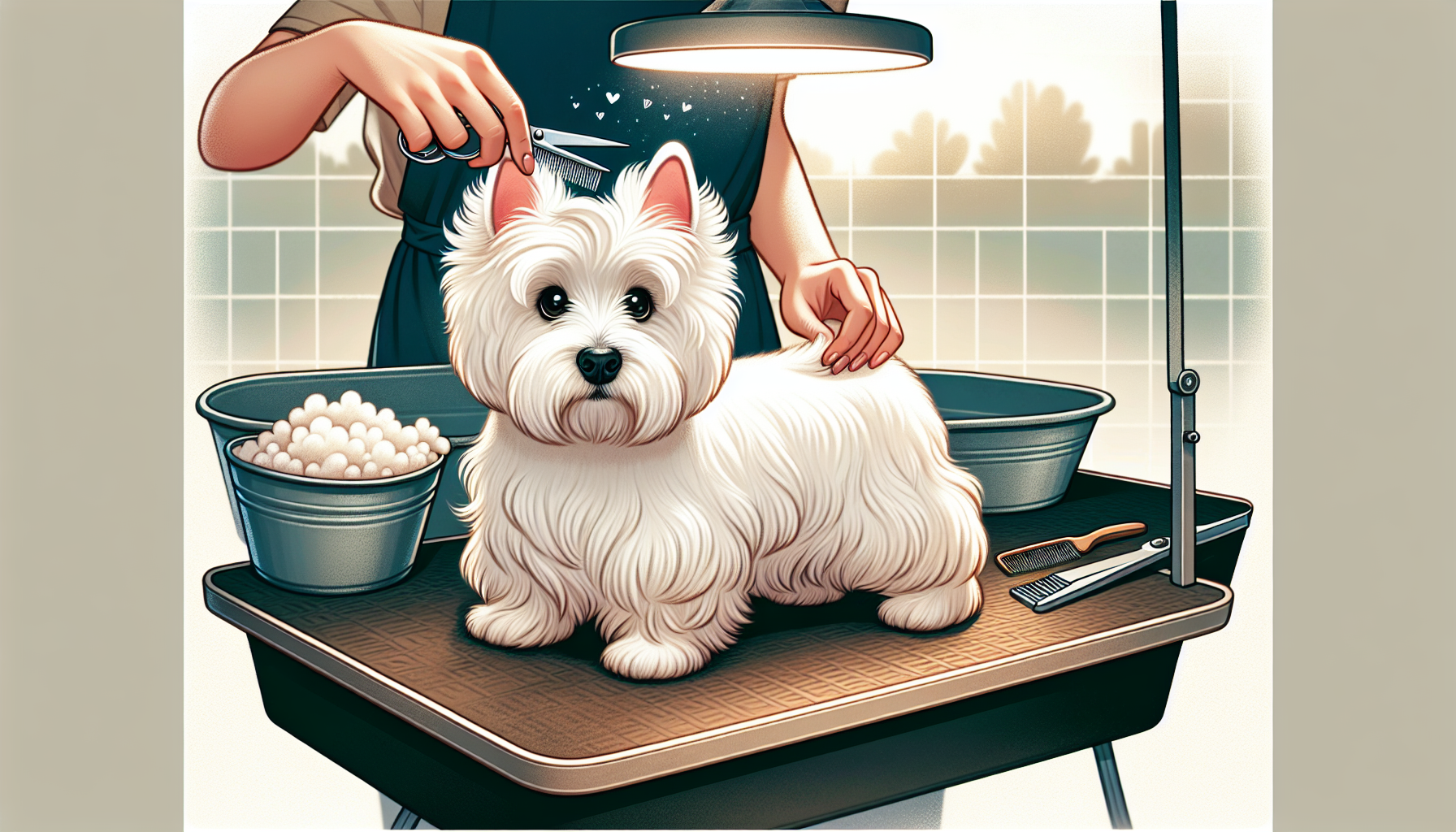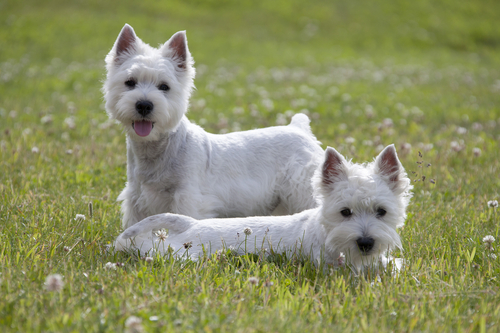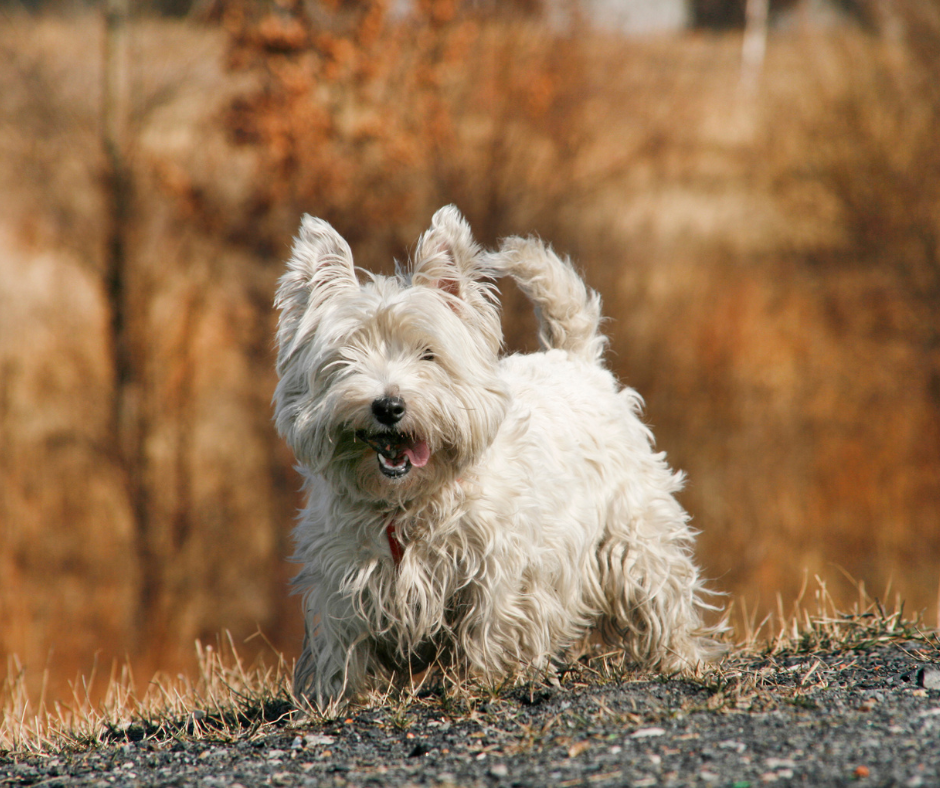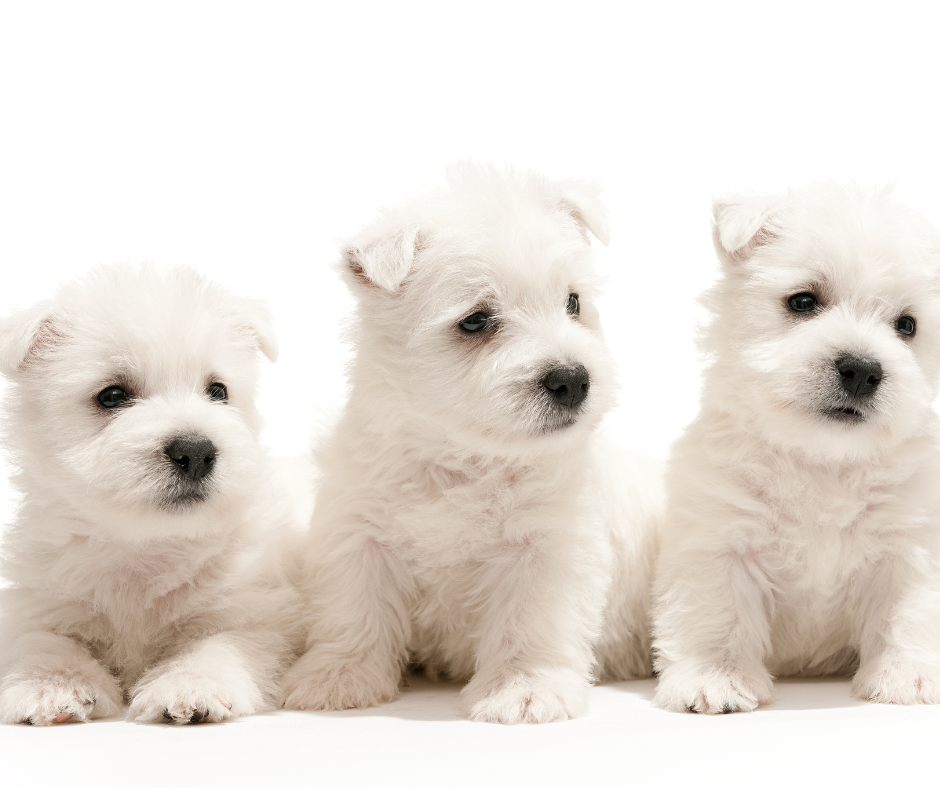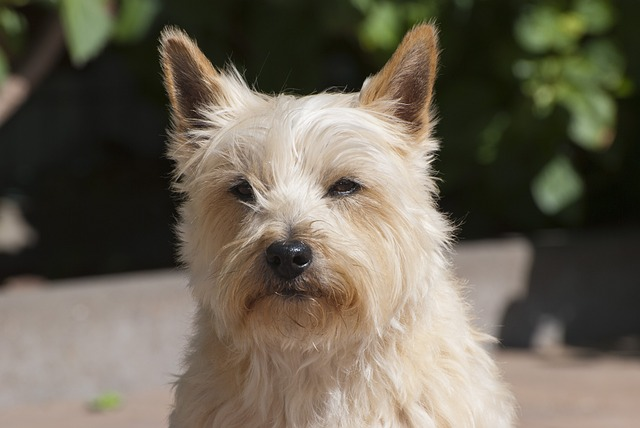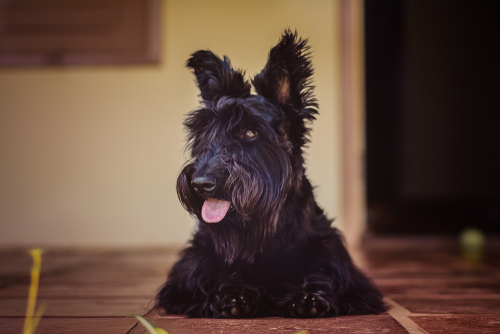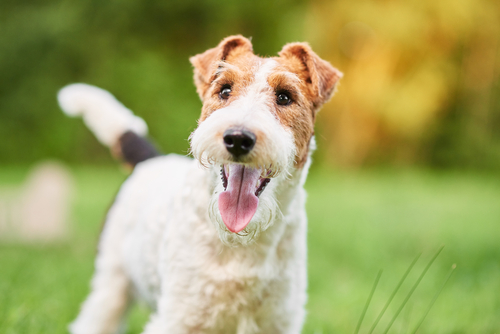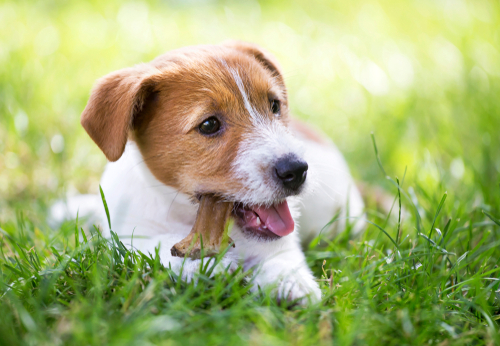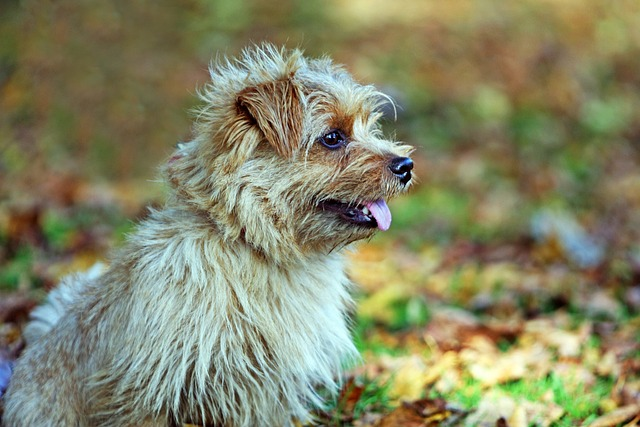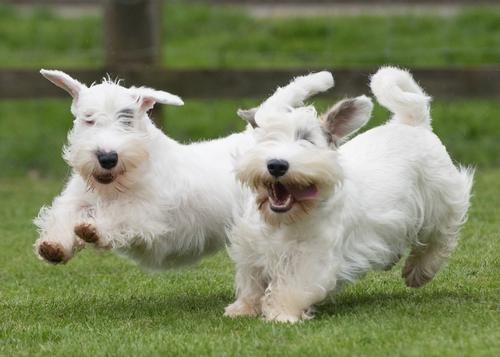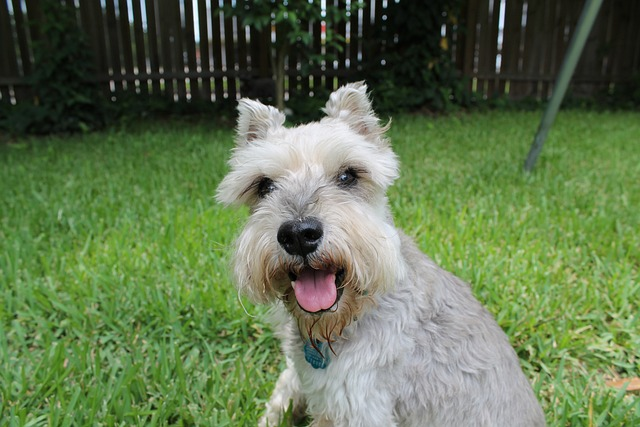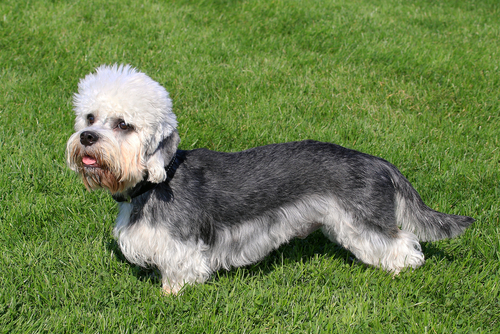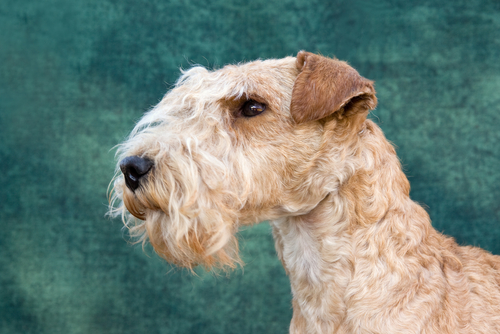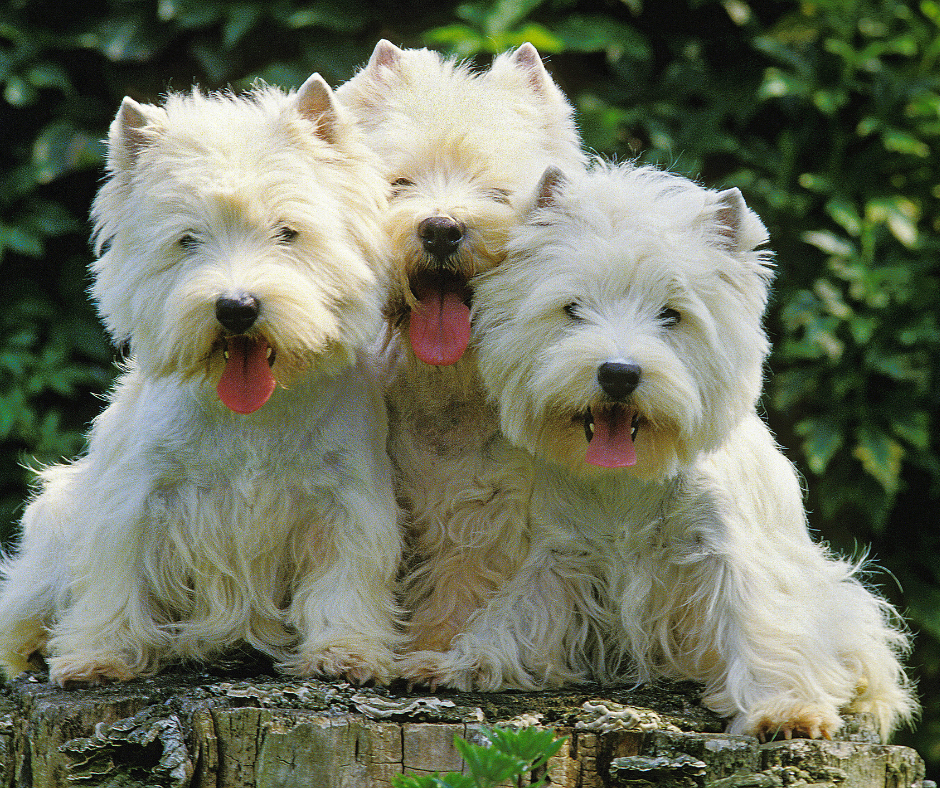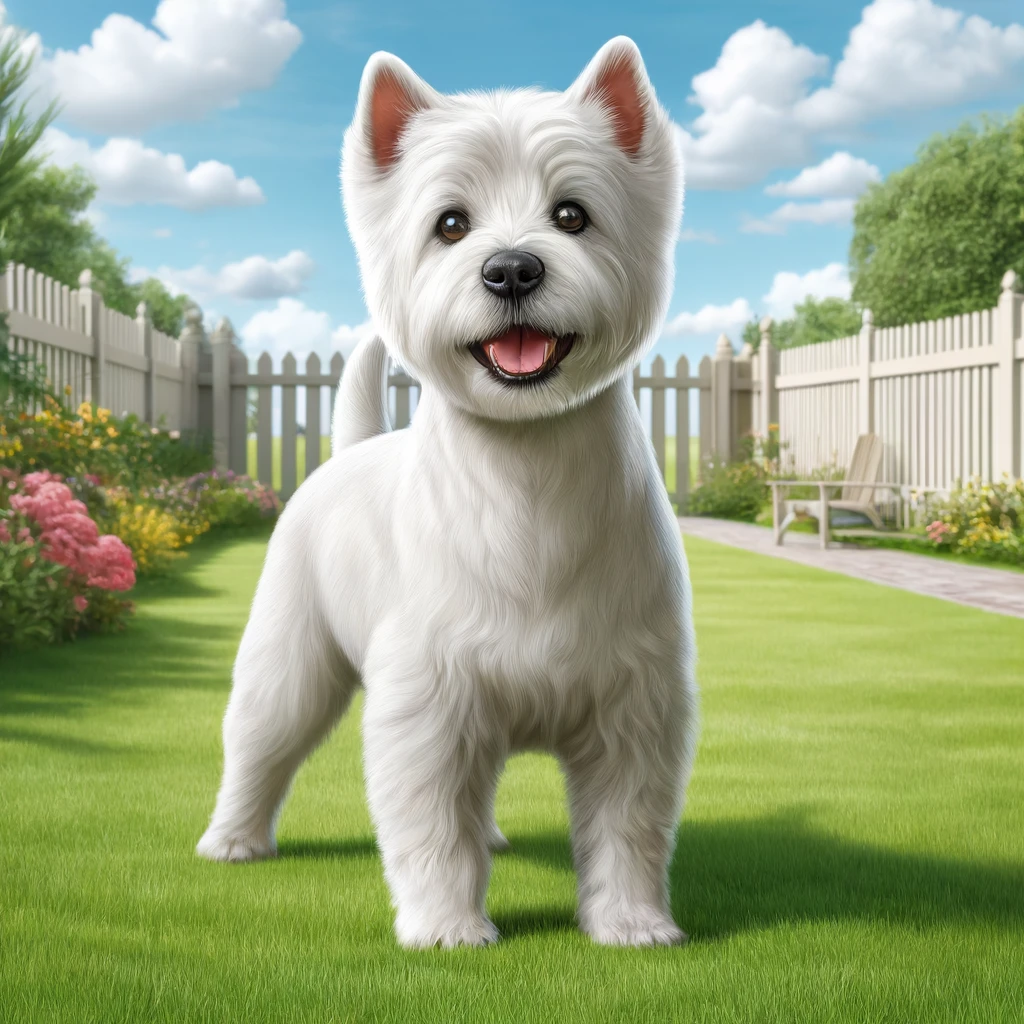West Highland White Terrier

Scotland is home to many modern terrier breeds, including West Highland White Terriers, Cairns, Skyes, Dandie Dinmonts, and Scottish Terriers. These loyal dogs have served as hunting companions for centuries, their small size enabling them to chase foxes, badgers, martens, weasels, and rodents into tight spaces. Landowners selectively bred terriers for specific traits, such as the Westie’s white coat to avoid being mistaken for prey.
The West Highland White Terrier is an excellent hunter with a cheerful personality, perfect for playtime. Known for their fashionable appearance, they look great in plaid raincoats. These adaptable dogs thrive in urban, suburban, and rural settings. Their lively nature, bright white fur, and sparkling eyes make them universally loved.
The Westie’s thick, fluffy double coat consists of a soft undercoat and a medium-length topcoat, offering protection from harsh weather and predators. True Westies are snowy white, as any other color is considered a fault by show standards. Despite their cute appearance, Westies have high energy levels and love to dig, run, and hunt. While some of this behavior can be managed with training, they are known for their independence and vigor, which some may find noisy or destructive.
Westies need regular exercise and training to curb disruptive barking or digging. They excel in American Kennel Club earthdog trials, agility, obedience, flyball, and other canine sports, which help manage their high energy and stimulate their intelligent minds.
The Westie’s signature rough coat may shed but is manageable with regular brushing and occasional professional grooming. Many owners prefer clipping for convenience, but hand-stripping, which removes dead hair using special tools, maintains the breed’s distinctive look and is essential for show dogs. This meticulous process requires time and effort but yields stunning results.
West Highland White Terrier: Essential Breed Guide for Prospective Owners
Are you considering bringing a West Highland White Terrier into your life? Known for their distinctive white coats and spirited personality, Westies offer a blend of independence and affection that makes them endearing companions. This article will navigate you through everything from their playful nature and grooming needs to health considerations and training tips, equipping you with essential insights into raising a well-adjusted and happy West Highland White Terrier.
Key Takeaways
- Westies, originally from Scotland and bred for hunting, have become affectionate, independent family pets that require daily physical and mental stimulation to stay happy and healthy.
- Prone to certain health issues like diabetes and skin conditions, Westies need a balanced diet, regular vet check-ups, and daily exercise to maintain their well-being.
- Training a Westie should start early with positive reinforcement and consistency, and socialization is key to manage their strong prey drive and tendency to bark.
Discovering the West Highland White Terrier
Westies, as they’re affectionately known, are small, robust terriers recognized for their distinctive white coats. Originating over 300 years ago in the Scottish Highlands, they quickly captured the hearts of dog lovers with their:
- confident and entertaining nature
- cheerfulness
- activity
- curiosity
- independence
They were bred for hunting but have transitioned seamlessly to becoming beloved family pets and playmates, making them excellent additions to any family.
The Unique History of Westies
Starting life in Scotland, Westies were originally bred for hunting:
- foxes
- badgers
- otters
- vermin
Over time, white dogs with their distinctive white coats and playful nature won hearts worldwide, and they transitioned from hunting dogs to cherished family pets for many pet owners and were recognized as purebred by the AKC in 1908.
Today, Westies are among all the terrier breeds, adored for their lively nature that harkens back to their hunting origins. They are also known as the roseneath terrier or poltalloch terrier in some regions.
Read More: A History of Dog Breeding
Physical Characteristics: More Than Just a Pretty Face
Westies have the following characteristics:
- Males typically stand 11 inches tall and weigh between 15 and 20 pounds
- Females tend to be slightly smaller, standing 10 inches tall and weighing 13 to 16 pounds
- They have a compact body and dark, piercing eyes
- Their distinctive carrot-shaped tail and all-white double coat distinguish them from other breeds.
Temperament: The Heart of a Westie
At the heart of each Westie is a bold, confident, fun-loving, intelligent, friendly, and spunky temperament. While they are calm and quiet indoors, they exhibit a fun-loving and active disposition when outside, displaying varied energy levels – some enjoy their time as lapdogs while others display bursts of hyperactivity. Though generally friendly and sociable, their tendency to bark can sometimes be misinterpreted as aggressiveness.
Their strong prey drive requires proper training and socialization to manage.
Health and Wellness for Your West Highland Terrier
Like all dog breeds, Westies are prone to several common health issues, including diabetes, skin conditions like allergies and dermatitis, and ear disorders such as otitis. These issues range from minor to fatal and may be attributed to genetic or environmental factors.
Preventive care, including addressing potential issues like cruciate ligament disease, is crucial to ensure the long-term health and happiness of your Westie.
Navigating Health Issues in Westies
Navigating the health issues of Westies involves a combination of proper nutrition, exercise, and regular check-ups with a veterinarian. Certain dog foods designed for Westies, for instance, contain beneficial supplements like glucosamine and chondroitin that support joint health. Westies may also experience eye disorders such as dry eye, corneal ulceration, and cherry eye.
Contributing to breed-specific research studies by providing blood or DNA samples can help in understanding and managing their health better.
Keeping Your Westie Fit and Healthy
Keeping your Westie fit and healthy involves:
- At least 45 minutes of daily exercise to stay fit and mitigate the chances of developing destructive behaviors
- Daily walks
- Interactive play with puzzle toys
- Other forms of mental stimulation
These activities are essential for keeping Westies, which are generally healthy dogs, engaged and ensuring they remain healthy dogs.
Feeding them a natural, whole food diet with raw ingredients can help prevent obesity, joint, dental, and digestive issues, and reduce common allergy symptoms.
Grooming Your West Highland White Terrier
The Westie’s unique coat consists of a soft, dense, and woolly undercoat, with a silky and medium length outer layer of guard hairs. Regular brushing is necessary to maintain the coat’s coarse texture, and trimming the hair between the Westie’s pads is beneficial for maintaining clean feet and preventing foot-related issues.
Though Westies don’t require baths very often, when they do, it’s important to ensure that over-bathing does not strip their coat of natural protections due to a lack of oily residue.
Coat Care Essentials
Regular grooming is essential for Westies to maintain their double coat. Here are some tips:
- Use a pin brush or rake, depending on the coat type, to remove knots and tangles.
- Pay special attention to sensitive areas like the armpits to prevent matting.
- Carefully clip out any mats that you find.
- Use a gentle shampoo specifically designed for the Westie’s wiry terrier coat to preserve natural oils and prevent dryness.
A Westie’s home grooming kit should include shampoo, conditioner, a proper brush, and ear-cleaning solution.
Bathing and Beyond
When bathing a Westie, use a mild shampoo and, if needed, conditioner, finishing off with a blow dry to fluff up the coat using a slicker brush. Clipping a Westie’s coat should be done every 4 to 8 weeks, depending on the owner’s personal preference and how they maintain the coat’s length between clippings. A part of a Westie’s grooming routine should include trimming around and under the tail, using a stripping knife, hand plucking, or thinning scissors.
Training and Socialization: Raising a Well-Behaved Westie
Westies are intelligent dogs that require consistent training to manage their stubborn behavior. To make training effective, the owner must establish themselves as the pack leader for the Westie to listen and obey commands. House training and teaching basic commands to Westies can start as early as 8 weeks old, focusing on a positive reinforcement method without any punishment.
Positive reinforcement paired with consistency is key to successfully training a West Highland White Terrier.
Mastering Basic Commands
Westies, stemming from a background as working terriers, possess gameness and courage which can be both a challenge and an asset in training due to their independent nature. Beginning training during the four to six week imprinting phase can result in more effective learning, considering that young Westies have shorter attention spans. During training, it’s essential to reward quiet behavior and provide calm, firm instructions to manage the Westie’s natural propensity to bark.
Conducting short training sessions focused on one command at a time helps in keeping a Westie engaged and prevents them from being overwhelmed. Essential commands include:
- sit
- stay
- come
- leave it
- drop it
Professional trainers and puppy classes are valuable resources, aiding in preparing Westies to be comfortable at home and providing guidance through their growth stages, especially in crate training and socialization.
Read More: Dog Training 101
Socializing Your Westie: Friends or Foes?
Socializing a Westie successfully involves:
- Exposing them to various new environments
- Consistently rewarding them for calm and non-aggressive behavior
- Socializing them with other dogs, as Westies tend to get along well with them
- Socializing them with cats from a young age, although they have a strong instinct to chase small animals
- Providing activities that provide mental stimulation, as Westies particularly enjoy chasing and activities that provide mental stimulation
These steps should help in socializing your Westie with other pets.
Rescued West Highland White Terriers may require additional patience during socialization, as their previous experiences and background could affect their behavior with humans and other animals.
See our Complete Socialization Checklist Here
Living with a West Highland White Terrier
Westies are more independent than other dog breeds and can tolerate being left alone for a few hours. Some Westies can enjoy swimming, but should always be supervised during such activities.
This section will delve into the nuances of setting up a Westie-friendly home environment and how to balance alone time and companionship.
Home Environment: Keeping Your House Cool and Westie-Friendly
Initially confine a Westie puppy to one or two rooms to prevent them from feeling overwhelmed in large, busy households. Creating a safe environment for a Westie involves:
- Removing hazardous items such as wires, small chokeable objects, and toxic substances
- Selecting a crate for your Westie that will be comfortable throughout their growth and provide a sense of security
- Providing at least two sets of soft and plush bedding for your Westie, to ensure comfort and maintain cleanliness.
West Highland White Terriers are adaptive and can live comfortably in any size of home, including apartments.
Balancing Alone Time and Companionship
Crate training is crucial for helping Westies cope with being alone without feeling abandoned. Properly implemented crate training can prevent destructive behavior in West Highland White Terriers when they spend time alone. Training should address specific undesired traits in Westies, such as excessive barking, to maintain a harmonious home environment.
Unmanaged excessive barking can lead to issues within the household, reinforcing the need for consistent training.
The Joy of Dog Sports and Activities with Your Westie
West Highland White Terriers can participate in a variety of dog sports, with flyball being an area where they particularly excel. In flyball competitions, Westies can achieve titles from Flyball Dog to Flyball Grand Champion, demonstrating their speed and dedication to the sport. Flyball events offer a vibrant atmosphere comparable to horse racing and provide an exciting showcase of the competing dogs’ energy and competitive spirit.
This section will delve into the various activities that Westies can participate in and their playtime favorites.
Agility and Obedience: A Perfect Match for Westies
Flyball, a sport that involves a combination of speed, precision, and teamwork around tennis balls, is well-suited for competitive Westies.
West Highland White Terriers, also known as Scottish Terrier cousins, are intelligent and energetic, qualities that make them excel in agility-based dog sports.
Playtime Favorites: Squeaky Toys and Puzzles
Interactive toys such as food puzzles can stimulate a Westie’s mind by challenging them to solve problems to receive treats. Westies require durable and size-appropriate toys, which can include chew toys for gnawing, soft toys for comfort, and fetching toys for dental health and exercise.
Choosing the Right West Highland White Terrier: Adoption and Breeders
When choosing the right Westie, you should consider reaching out to the national breed club or a local breed club for guidance on Westie rescue for adoption. Always prioritize adopting West Highland Terriers from rescue organizations or shelters.
Before buying or adopting a West Highland White Terrier, remember that they are lovable and require responsible ownership. If you decide to buy a Westie puppy, remember to do thorough research of the breeder to ensure they prioritize the ethical treatment and well-being of their dogs.
Finding a Reputable Breeder
Reputable Westie breeders are known for their steadfast dedication to the breed’s welfare and consistently strive to produce healthy and well-tempered puppies. Responsible Westie breeders should provide:
- Health clearances for hip dysplasia, elbow dysplasia, hypothyroidism, von Willebrand’s disease, thrombopathia, and normal eye conditions to ensure the health of their puppies.
- Time to understand each puppy’s personality and needs to match them appropriately with potential owners, which can sometimes extend the process of acquiring a puppy to a year or longer due to their careful placement practices.
- Continued support and advice after purchasing a Westie, as well as provide a contract and warranty for the puppy’s health and well-being.
Prospective Westie owners can connect with reputable breeders through various avenues such as:
- Attending dog shows
- Earthdog tests
- Westie Club meetings
- Local kennel club meetings
These events, often organized by the American Kennel Club, provide opportunities to learn more about the breed and meet breeders.
The Rewards of Adopting a Westie
Adopting an older West Highland White Terrier from a rescue or shelter can lead to a rewarding experience with a dog that may be eager to show gratitude and love. This is a wonderful way to provide a loving home for a dog in need, and it’s a decision you’re unlikely to regret.
Feeding Your West Highland White Terrier: Nutrition and Diet
Feeding a Westie requires a balanced diet that considers their specific nutritional needs and potential sensitivities. A healthy diet for a Westie consists of high-quality protein, healthy fats, essential vitamins and minerals, and fiber, and should take into consideration breed-specific formulations with ingredients like maize flour, dehydrated poultry protein, rice, animal fats, and fish oil. When introducing treats into the Westie’s diet, it’s crucial to exercise caution as they can be prone to allergies, necessitating the selection of suitable snack options and close monitoring.
Determining the correct amount of food for an adult West Highland White Terrier involves considering the following factors:
- Age
- Size
- Build
- Metabolism
- Activity level
Recommended amounts for high-quality dry food range from 1/2 to 1.5 cups daily.
Read More: The Best Dog Food For Small Dogs
Diet Considerations for a Westie’s Sensitive Stomach
Westies with sensitive stomachs may benefit from hypoallergenic or limited ingredient diets to minimize digestive issues and allergic reactions. Consulting with a veterinarian can help in choosing the right food for a West Highland White Terrier with specific dietary requirements like allergies and diabetes.
Treats and Training: A Balanced Approach
Using treats as positive reinforcement in training can be effective for Westies. Training treats should be small and low-calorie to prevent overfeeding. It’s essential to maintain a balance with their overall diet to avoid weight gain and health issues.
Dog Breeds Similar to the West Highland White Terrier
Several dog breeds share traits and characteristics with Westies, such as:
Cairn Terriers
Scottish Terriers
Wire Fox Terriers
Jack Russell Terriers
Norfolk Terriers
Sealyham Terriers
Miniature Schnauzers
Dandie Dinmont Terriers
Lakeland Terriers
Border Terriers
These breeds, like Westies, are known for their robust constitution, bold personalities, and adventurous spirits.
Understanding these similarities and differences can help you appreciate what makes Westies a unique and lovable breed.
Summary
In conclusion, West Highland White Terriers are a delightful breed, known for their fun-loving nature, distinctive white coats, and robust constitution. Whether through adoption or purchasing from a reputable breeder, owning a Westie can be a rewarding experience filled with love and companionship. With the right care, training, and diet, these intelligent and energetic dogs can make a wonderful addition to any family.
Frequently Asked Questions
Are West Highland White Terriers good family pets?
Yes, Westies are great family pets due to their loving and adaptable nature, making them a wonderful addition to any household.
Do Westies have a tendency to bark?
Yes, Westies have a tendency to bark, as they are known to enjoy barking and may do so just for the sake of it.
How much exercise does a Westie need?
A Westie needs around an hour of exercise each day, along with off-lead play in secure areas to stay healthy and happy.
What are the grooming needs of a Westie?
To keep a Westie’s fur healthy, brush it a few times a week and take it to a professional groomer every six weeks to prevent matting and maintain its coat.
Can Westies get along with other pets?
Westies may not be the best fit for homes with smaller pets due to their prey drive, but they can coexist with cats if raised together. Be cautious and monitor their interactions.
- Group AKC Terrier
- Origin United Kingdom
- Size Small
- Weight 15 to 22 pounds
- Coat Length Medium
- Coat Type Double
- Colors White
- Other Names Poltalloch Terrier, Roseneath Terrier, White Roseneath Terrier, Westie
- Temperament Affectionate, Alert, Courageous, Intelligent, Friendly, Hardy, Independent













